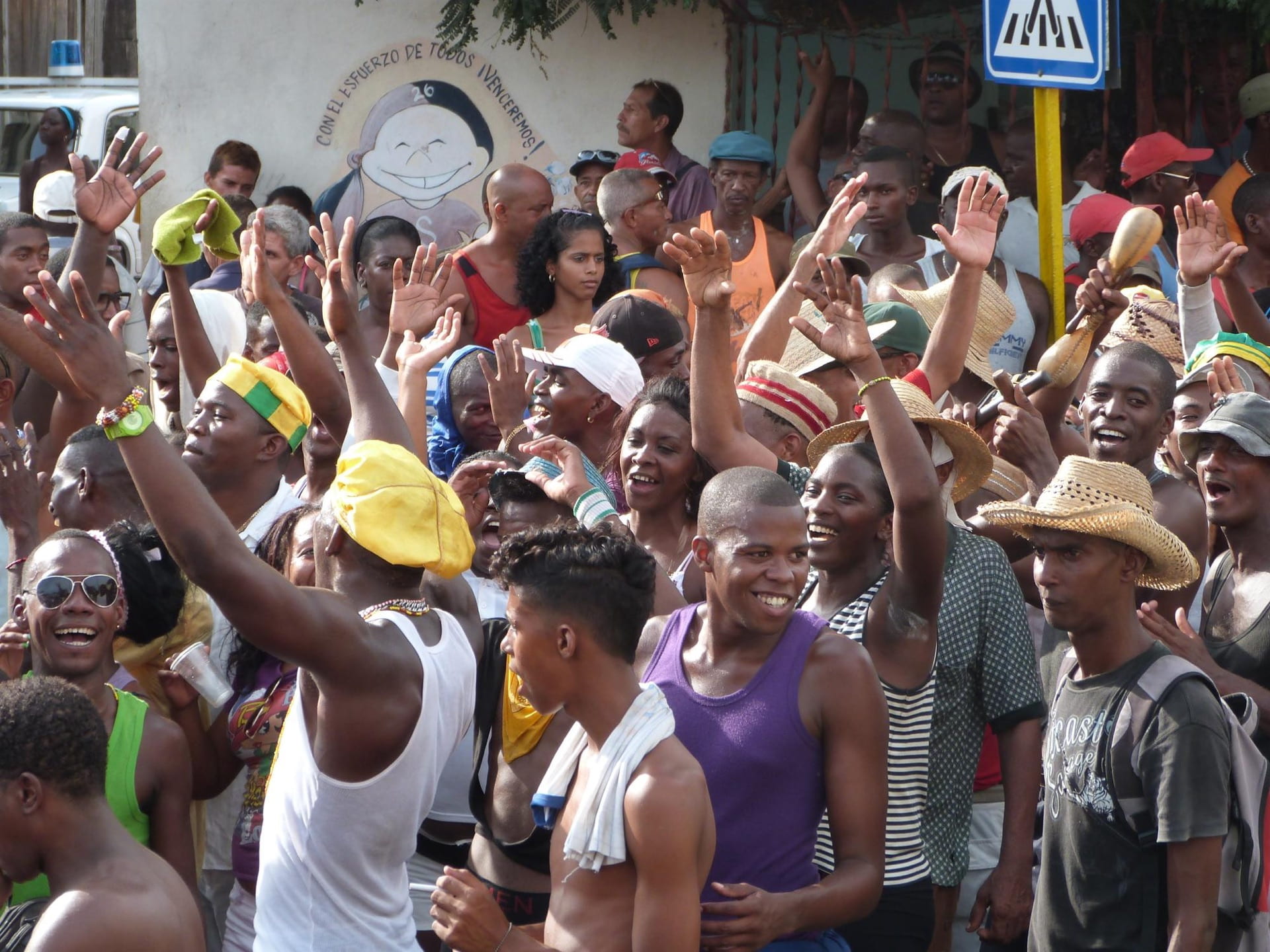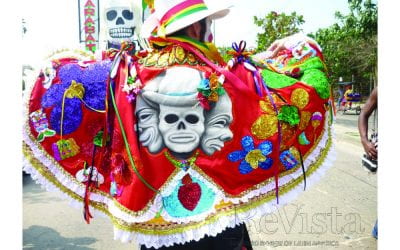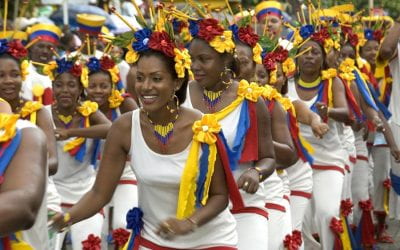La Conga
Santiago de Cuba’s Badge of Honor

Santiago de Cuba’s congo goes back to a time at the end of the sugar harvest when slaves were allowed to play their music and dance in costume in the streets. Photo courtesy of Daniel Chatelain.
I was trying desperately to sleep, but it was too cold. It was July in Cuba, but the air conditioning on the cross-country Viazul bus had two settings—“freezing” and “off.” I was on the overnight bus from Havana to Santiago de Cuba and I hoped the 15-hour ride would be better than the train. I had waited in line for two days for that train only to be told I was number 347 on the waiting list, and so I decided to splurge on the slightly more reliable bus. “This better be worth it,” I thought, as I pulled my towel tighter around me.
I had been studying percussion for eight months in Havana, and had soaked up as much music as I could, running around the city to attend religious batá and palo ceremonies, the symphony, toques espirituales, jazz clubs, internationally recognized percussion festivals, rumbas and outdoor timba (Cuban salsa) concerts attended by 30,000 people. As summer neared, I started to hear a lot of buzz about carnaval in Santiago de Cuba, and about how it was “the real carnaval.” That’s how I found myself on that freezing cross-country bus.
Once in Santiago, I wandered through the city and took in the carnaval activities that surrounded me. Vendors were selling roast pork and cheap fluorescent plastic toys and hair accessories, while timba blasted from speakers and couples drinking watery beer drawn from enormous vats danced in the streets. Comparsas (costumed, choreographed groups of music and/or dance) paraded down the promenade, followed by the paseos with their glittery floats and girls in sequined g-string bikinis. It felt like a giant party. But after a couple of days, I found all the choreography, costume and glitter a little monotonous and worried that perhaps the 15-hour bus ride was in vain.
Then, one night, a friend and I were strolling through a residential area slightly removed from the main carnaval scene. Suddenly I heard something from off in the distance that generated an uneasy feeling in my stomach. The sound, unnervingly unfamiliar to me, came closer, and the ground shook softly. Moments later, I glanced behind me and saw a human wave cresting on the horizon. I was transfixed by this mass and rhythm that was clanging and throbbing its way towards me. As the crowd approached, my friend grabbed my arm and pulled us into the middle of the throng. The ground vanished beneath my feet! I was pressed hard up against strangers, sweaty and sticky from exertion, their knees knocking into me, their elbows in my ribs, as my flip-flops were trampled and left behind forever. What was unfamiliar to me was obviously not so for the revelers, who knew and repeated a number of lined-out coros (choruses). Despite the seeming chaos, somehow we were all moving together, in perfect syllabic synch to this wonderful and alarming sound. We moved through the streets, as if on a conveyor belt, writhing en masse, a human wave of energy, well over the line of “in-control” and “safe.” After a while, my friend and I managed to extricate ourselves from the rest of the cyclone and catch our breath while the procession surged on without us. “What was that?” I asked, stunned. “That,” my friend grinned, “was a conga.”
After my first experience with conga in 2003, I resolved to learn more about this phenomenon which contrasted so deeply with the tightly choreographed, costumed, more obvious face of Santiago’s carnaval. I quickly discovered, however, that it was almost entirely absent from the extensive literature on Cuban music, save for a few one-line definitions. Desi Arnaz had of course popularized the “conga line” in the United States in the 1950s, but I couldn’t draw many parallels between what I had seen on I Love Lucy and what I had experienced that evening in Santiago. Ironically, Arnaz’s father was mayor of Santiago from 1923-1932, and had repeatedly tried to ban the conga for its “dangerous” and “contaminating” morals. Likewise, Gloria Estefan’s 1985 hit Conga didn’t seem to correspond to what I had seen.
I eventually decided to focus my 2008 Master’s thesis on the subject, working with Cuba’s most famous conga from the neighborhood of Los Hoyos in Santiago de Cuba. I arrived at a definition of conga as “a neighborhood-based carnaval group that proceeds through the streets playing specific rhythms and using certain instrumentation, collecting non-musician participants en route.” It became clear to me that conga is much more than a type of carnaval music, however. It is a social and musical phenomenon that is unique to eastern Cuba, one that is especially associated with Santiago de Cuba—a fascinating product of the region’s complex and unique demographic. It is also an important source of pride for a region that has historically been denigrated by its western counterpart.
MUSIC AND MOVEMENT
Santiago’s conga has its roots in 17th century exhibitions by the various cabildos (mutual aid/slave nation societies).Authorities designated a time at the end of the sugar harvest when slaves were allowed to play their music and dance in costume in the streets. The large population from Saint-Domingue that had come to Santiago following the Haitian Revolution became one of the most prominent communities in the city and in the emergence of carnaval. Other highly visible groups contributing to carnaval included slaves from the central Congo and Calabar (Cross River State, Nigeria) regions of Africa (in Cuba, those descending from the latter are known as Carabalí.) The early 20th century also saw a large influx of migrant workers into Santiago from Jamaica, Haiti and other parts of the Caribbean—hence Santiago’s moniker, “the most Caribbean city on the island.”
The elements that compose Santiago-style conga are particular to the east. The instrumentation includes bass drums likely taken from the Carabalí cabildos or perhaps Spanish military bands, as well as bocuses, which are basically portable versions of Congolese yuka drums. Frying pans mounted on wood blocks have been replaced by llantas—car brake drums—which are struck with a metal rod. The hallmark of conga, the corneta china, or Chinese trumpet, was brought to Cuba in the 19th century by Chinese migrant workers. Upon hearing the shrill, piercing sound of the corneta china, only one thought springs to mind for Cubans: ¡Santiago!
The congas of Santiago play three basic rhythms that are unique to these ensembles. One of these, masón, is taken directly from the Tumba Francesa repertoire. These were societies formed in Santiago, Guantánamo and surrounding rural areas in the early 19th century to perpetuate Saint-Dominguan culture in Cuba. The other two rhythms, pilón and columbia, are unrelated to the popular pilón or rumba columbia rhythms and instead belong exclusively to conga. The movement associated with conga, called arrollando, is a march characterized by exaggerated hip swaying, and is not found anywhere else in Cuba, though similar movements are found across the Caribbean. All these elements combine to form something special that you won’t find outside of Oriente, the eastern region of the island. The experience of arrollando, roaming through the streets in conjunction with all these elements and people, is indescribable and unforgettable. Indeed, the best piece of advice I received in the field was from a librarian at Santiago’s Biblioteca Elvira Cape, who told me: “Do your research, interviews, recordings, etc. But don’t forget to just arrollar.”
CONGA—A SOURCE OF PRIDE
Santiago is famous island-wide for its carnaval and especially its congas. Carnaval attracts people from all parts of the island who wish to participate in its activities, especially in the invasión. The invasión is the conga event which unofficially kicks off carnaval, during which the conga of Los Hoyos travels through the streets “invading” the other five rival congas’ neighborhoods. Upon arrival in a neighborhood the rival conga and that of Los Hoyos show off their respective groups’ rhythmic chops in competition. It is a massive event, and according to legend, in one year there were 30,000 people arrollando in the invasión through Santiago’s streets. In the documentary Uprising, by Blue Throat Productions, Santiaguer@s (people from Santiago; the @ stands for both masculine and feminine plurals in Spanish) expressed sentiments such as “Conga is our kingdom,” and “if it were up to me, there’d be a conga every day. It’s my life.” My own interviews yielded similar comments. You will never see Santiago de Cuba play a baseball game (especially against theIndustriales, Havana’s team) without a conga present in the stands. It’s the ultimate representation of the city, which is the de facto capital of the Oriente region.
One day, I was walking through the streets with 25-year-old Vladimir, the well-known corneta china player with the conga of Los Hoyos. We rounded a corner and came upon a group of boys—six to nine years old—shirtless, shoeless, and playing with empty gas cans and plastic bottles. The moment they saw Vladimir they snapped to attention, and one mimed a corneta china while proudly tooting the opening tune of one of Los Hoyos’ songs. The other boys, without missing a beat, answered with the appropriate choral response and instantaneously turned their pieces of trash into functioning instruments. They proceeded to play the pilón rhythm with a precision and vigor that astonished me. Their eyes were on fire, eagerly searching for approval from Vladimir. He chuckled, looked shyly at the ground, shook his head and said, “Aw heck no, this tradition is never going to die.” The true value of conga crystallized for me in that moment. In Santiago, childhood heroes are conga members, and children’s congas that function to train the next generation of players are voluntarily well-attended. As Felix Banderas, director of the conga of Los Hoyos once told me, “when you are born in Los Hoyos, you are born inside a [conga’s] drum.”
The importance of conga to Santiago’s identity was dramatically displayed with the release of the song Añoranza por la conga (Yearning for Conga), by the popular music group from Santiago, Sur Caribe. The song tells of a girl from Santiago who has left Cuba, but all she can think about is the conga from her hometown. She is tormented by the pain of no longer being able to feel the power of arrollando with the conga of Los Hoyos, where you might see “a cockroach dance with a cat,” a metaphor of unity across social classes. The song opens with the jarring sound of the corneta china and the high-pitched clang of the llantas. Then, an arrangement for string orchestra and trombone unfolds on top of the conga of Los Hoyos. The result is an irresistible march bursting with regional pride. But it is not merely a lament for a lost homeland. It is also a celebration of Santiago and things only a Santiaguero can understand. It elevates Santiagueros and gives them a distinction they rarely enjoy in the capital. As the song ends, the strings and brass fade out, and the full percussion of the conga returns. The chorus drives the message home, repeating “¡Oigan Santiaguer@s, sigan adelante!” (Listen up people of Santiago, keep moving forward!) as the conga of Los Hoyos plays relentlessly.
EAST VS WEST
Over the last decade of working with Cuban musicians on the island and abroad, it became clear to me that easterners have a certain reputation among those from the capital. I have heard them described with such harsh terms as “underdeveloped,” “savage,” “inferior,” “illiterate” and “primitive.” Heavy migration to the capital from the east has caused Orientales to be blamed for Havana’s housing shortage and high unemployment rate, and has earned them nicknames such as “palestin@” and “indocumentad@” in reference to a people without a homeland. Musicologist Rebecca Bodenheimer discusses examples of such regional tensions, which are illustrated in Cuban popular dance music, in her article titled La Habana no aguanta más: Regionalism in Contemporary Cuban Society and Dance Music (Musical Quarterly, 2009:3-4.) Indeed, there is a long history of tension between the east and the west of the island, which historian Ada Ferrer details in her work Insurgent Cuba: Race, Nation, and Revolution, 1868–1898 (Chapel Hill, 1999.) These tensions have resulted in a kind of shame felt by some Orientales, and a reluctance to disclose their origins. Orientales are often accused of “haciendose el habanero”—pretending to be from Havana. They change their accent, omit certain words from their vocabulary, and increase the amount of “bling” in their wardrobe to avoid being identified as an Oriental, or, as one friend from the eastern province of Holguín admitted, to make themselves feel “more advanced like those from the capital.”
In 2006, “Añoranza por la conga” hit number one across the island and won the prestigious Cubadisco award for Song of the Year. This was a surprising and important moment for the east and the Havana-based commercial music industry. The song highlighted the unique identity of Santiaguer@s, and reinforced the relevance of eastern Cuban traditions like conga across the island.
Despite the Cuban government’s focus on cultivating a united national identity, regional tensions still exist. Conga has become a symbol of unification for eastern Cubans, especially Santiaguer@s, and also a site for the construction of an identity distinct from their western counterparts. While I myself am always somewhat anxious to leave Santiago and get back to Havana with its faster internet connections, abundance of restaurants, and flashy salsa scene, I never forget that extraordinary thing you can’t get in Havana: conga.
Spring 2014, Volume XIII, Number 3
Lani Milstein is an ethnomusicologist and producer living in Toronto, Canada. Her first article on conga, “Toward an Understanding of Conga santiaguera: Elements of La Conga de Los Hoyos” was recently published in the Latin American Music Review.
Related Articles
Festival and Massacre
Festivals are privileged spaces to help us understand the meaning of community. They are a special way of presenting historical narratives, bringing…
Fiesta and Identity
English + Español
In Barranquilla the days of Carnival begin early. From the first hours of the day—already confused with the last hours of the night—the smells of celebration are in the air. The streets…
Fiestas: Editor’s Letter
At the Oruro Carnival, a few hours from La Paz, the heavy-set blue-skirted women swirl past me in a dizzying burst of color and enviable grace. The trumpeters, some with exotically dyed hair, blare not too far behind. I remember that as a young man President Evo Morales had been a trumpeter in this very carnival.




